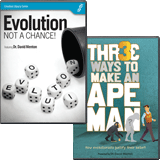
Gene Editing and Designer Babies—Why the Future Desperately Needs Us
The discovery of an easy way to “edit” genes may someday make it possible to manufacture “designer babies.” As science fiction becomes fact, humankind needs a biblical perspective now more than ever.
It was the year 2000, the spring of a new millennium. Wired magazine featured an eye-opening article by Bill Joy, cofounder of the upstart tech company Sun Microsystems. Under the guise of the cryptic title, “Why the Future Doesn’t Need Us,” the author issued the dire warning that we need to step back and reevaluate the dangers of our new technologies before it’s too late:
The new Pandora’s boxes of genetics, nanotechnology, and robotics are almost open, yet we seem hardly to have noticed. Ideas can’t be put back in a box. . . . Once they are out, they are out. . . . We are being propelled into this new century with no plan, no control, no brakes. Have we already gone too far down the path to alter course? I don’t believe so, but we aren’t trying yet, and the last chance to assert control—the fail-safe point—is rapidly approaching.
The semi-autobiographical piece was long and rambling, but it scared the pants off everyone who read it, including me. Given the propensity of science to do whatever it wants without any ethical safeguards, it seemed only a matter of time before society would self-destruct.
Fast forward 15 years. I think the dangers of nanotech and robotics were probably overstated, but recent advances in genetics are truly frightening. The dangers are so extreme that the National Academies of Science hosted a major international summit on gene editing in December 2015 in Washington, DC. As Wired put it, “Science would like some rules.”
In laying out his doomsday scenario in 2000, Bill Joy nonetheless thought that mankind could solve its problems: “In the end, it is because of our great capacity for caring that I remain optimistic we will confront the dangerous issues now before us.”
As a Christian and director of the Center for Bioethics at Cedarville University, I’m not reassured. Despite all the glib talk, the dangers are real. Only God’s Word provides the infallible perspective that mankind needs to avert disaster.
The Promise of Gene Splicing
The Human Genome Project, completed in April of 2003, was filled with promise. With the complete sequence of the human genetic code in hand, researchers could now begin to unravel the mysteries of the blueprint of life. This would allow a better understanding of how the body works and what causes genetic diseases. These new insights into DNA, which geneticist Francis Collins calls “the language of God,” have led to a genetics revolution.
It’s useful to identify what causes health problems, but that doesn’t fix them. The Human Genome Project has allowed us to read and better understand the code, but it has been virtually impossible to get inside the cell nucleus to make changes—until now.
The new genetic technique is called CRISPR, short for “Clustered Regularly Interspaced Short Palindromic Repeats” (see below). For the first time, this “gene splicing” procedure will allow the direct editing of specific genes.
Currently limited to the laboratory, CRISPR holds the promise of one day providing new cures for genetic diseases, including cancer and Alzheimer’s. Such dreams lie far in the future, as research on CRISPR will likely take years, probably even decades, before any human clinical treatments might emerge.
How Does CRISPR Work?
The Tool
Bacteria have a toolkit that scientists can use to find and replace sections of DNA corrupted by viruses. It has two parts: (a) a string of RNA (called CRISPR) that guides it to the right spot on the DNA, and (b) a protein (called Cas9) that cuts the DNA for replacement.
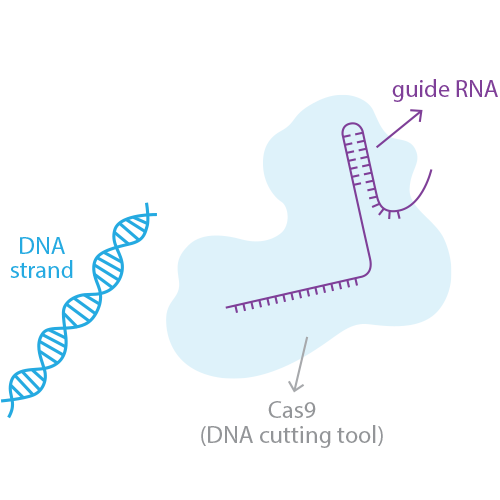
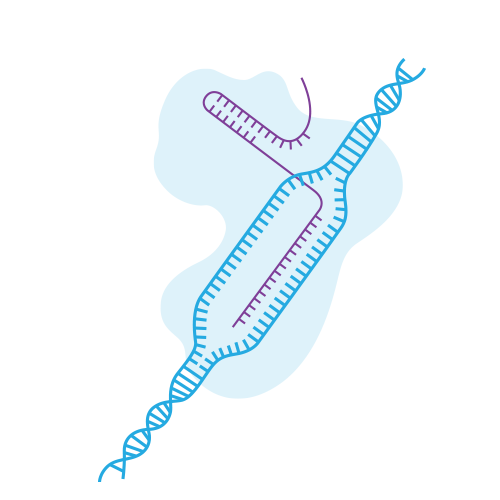
Find:
First the guide RNA (CRISPR) finds the string of DNA that needs replacing.
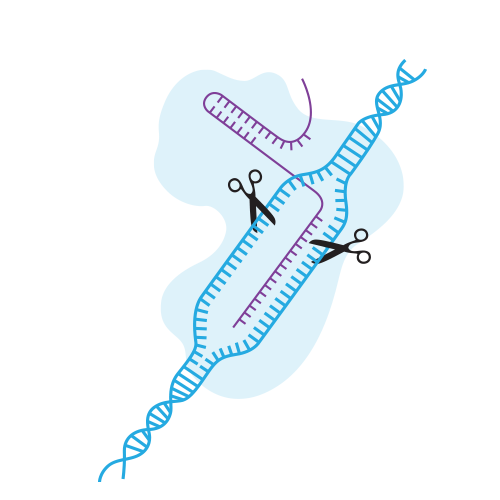
Cut:
Second, a protein (Cas9) cuts the DNA string that needs to be replaced.
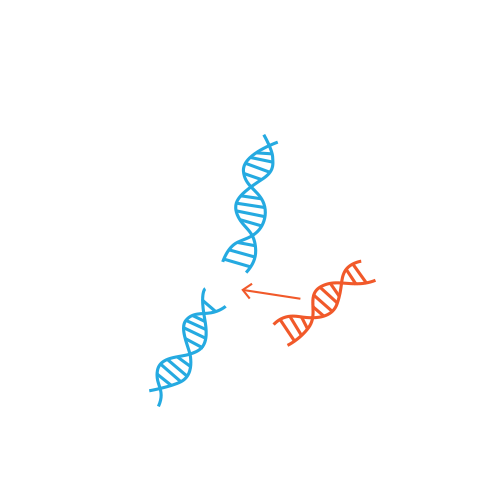
Replace:
Third, a new DNA string is inserted at the selected place.
A Firestorm
Initially the CRISPR technique was tested on animals and adult human cells, but in April of 2015 Chinese researchers published results from experiments on actual human embryos. This touched off a firestorm of protest. Why all the fuss?
Even if you accept the ethics of working on nonviable human embryos, the procedure doesn’t work very well. The Chinese researchers were testing a way to help people who suffer from a mutated gene causing a blood-cell disease called beta-thalassemia. Of the 86 nonviable embryos that were manipulated, only 28 showed the effects of the genetic “splicing,” and of these only 4 actually contained the desired changes. Meanwhile, many embryos showed undesirable “off-target” effects. The procedure is not even close to being ready for human trials, and all of the important research results of the Chinese study had already been reported in animal experiments. Using these techniques on humans was premature.
Of much greater concern is the enormous potential for bad outcomes from this incompletely tested technology. The Chinese scientists, for all of their apparent caution, crossed a sacrosanct ethical line: they modified a germline (the cells that can be passed down to descendants). This important distinction is the key to the ethical controversy. What if a new function enters the genetic pool of humans and gets spread to others without their permission?
It is relatively non-controversial to attempt to correct problems within cells of an individual’s own body. This is called somatic cell gene therapy and involves inserting the correct DNA into body cells (“somatic” comes from the Greek word soma for “body”). The replacement compensates for the defective gene. Even though this idea has been around for decades, treatments based on it are still considered experimental. Yet some clinical results are promising. For example, children with the lung disease cystic fibrosis have already received modest benefits from gene therapy, and a significant breakthrough may be just around the corner. Such treatments usually target only a specific organ, and affect only the patient.
On the other hand, germline therapies would alter an individual’s entire genome, including reproductive cells. These changes could be passed down to subsequent generations. A paper published by the European Molecular Biology Organization listed three of the greatest dangers: “There are several arguments against manipulating the human germline. To name just a few, these include that it is unfeasible to provide intergenerational consent, that the consequences are impossible to predict, and that such manipulations pose a threat to human dignity” (EMBO Reports, 16 (8): 879–880).
Note each point in turn. First, consent is important. There is no way to get consent from future generations for massive and permanent changes in their genome. Making such changes without permission violates the ethical principle of autonomy, wherein competent, informed patients make their own choices about medical procedures affecting their lives.
Second, there are unintended consequences. The unforeseen dangers of genetic manipulation have led many ethics professionals to recommend outlawing germline interventions altogether. There is simply no way to predict what effect such comprehensive changes would have on future generations. For now and the foreseeable future, it seems that these techniques should remain in the lab, and only in animals.
The third major concern is human dignity. Some voices are ignoring this concern and advocate rushing ahead without limits. For example, atheist psychology professor Steven Pinker would not recognize any biblical constraints on human value. Though he does not speak for all atheists, he has said about CRISPR, “Given this potential bonanza, the primary moral goal for today’s bioethics can be summarized in a single sentence: Get out of the way. A truly ethical bioethics should not bog down research in red tape, moratoria, or threats of prosecution based on nebulous but sweeping principles such as ‘dignity,’ ‘sacredness,’ or ‘social justice’” (Boston Globe, August 1, 2015).
Medicine should be about the business of relieving suffering, not second-guessing our Creator’s basic design.
So much for carefully weighing my biggest concern. Yet we cannot dismiss human dignity in such a cavalier way. This attitude ignores what God’s Word teaches about the creation of human beings in God’s image (Genesis 1:27). Throughout church history, leaders such as Augustine of Hippo and Thomas Aquinas promoted the idea of human dignity, and it has become integral to Western civilization. We are dependent beings; our nature, the sum of our physical and spiritual attributes, is not something we create. It is our given nature, making us distinctly human, with the Giver setting the boundaries and parameters.
What If We Could Make Safe Enhancements?
Suppose, for the sake of argument, that scientists could overcome all these objections. They could assure us that no “harm” would happen to the germline. Would it be acceptable to go beyond therapies for disease to make enhancements to the next generation of humans? Some would argue that such genetic “improvements” are no different from parents providing the best education for their children, along with top-notch orthodontics, designer clothes, and various extracurricular activities.
Such possibilities would not merely treat diseases but would change our actual genetic make-up based on personal preferences, creating “designer babies.” This all seems reasonable if human beings are nothing more than the random product of unguided evolution. In that case, there is no such thing as a given genetic nature, and we are free to take matters into our own hands, as long as no one is harmed in the process. But that’s not a biblical view.
We humans are not the arbiters of our own destiny. When God gave Adam the mandate to take dominion over the earth (Genesis 1:26–28, and continuing in Genesis 9:1), He did not include dominion over our fellow man. That’s still the Creator’s prerogative.
What makes genetic enhancement so ethically risky? It may ultimately change the way human beings regard themselves. In the past, we have had a high view of humankind as special. We even see this in our own Declaration of Independence, “We hold these truths to be self-evident, that all men are created equal, that they are endowed by their Creator with certain unalienable rights. . . .” This classic view, which was informed by Scripture, may give way to a new era, where we have perfectible humans with spare parts, whose nature changes with the fads of the day. Humanity will have lost its soul.
The bottom line is who controls our lives. The prophet Isaiah said it this way:
Surely you have things turned around! Shall the potter be esteemed as the clay; for shall the thing made say of him who made it, “He did not make me”? Or shall the thing formed say of him who formed it, “He has no understanding”? (29:16)
Christians must recognize and speak against the arrogance inherent in genetic enhancement, while they support genetic therapies that cure disease. Human beings as creatures must realize that our continuance in this world is at the pleasure of our Creator, “For in Him we live and move and have our being” (Acts 17:28). We do not make the rules; God does. The apostle Paul reminds us that we believers are not our own; we are bought with a price, and our bodies are temples of the Holy Spirit (1 Corinthians 6:19–20). Medicine should be about the business of relieving suffering, not second-guessing our Creator’s basic design.
Human beings are not made to order on a production line. Human enhancements (not including genetic therapies for disease) and designer babies would be an affront to the Creator God, who said on the sixth day after completing His creative work, including the first man and woman, that it was “very good.”
Glib reassurances such as those offered by Bill Joy will not suffice in the brave new world of genetic meddling. The future truly does need us, and it needs real answers, which Christians can share with a broken world, speaking out on behalf of the dignity of human beings made in God’s image.
Answers Magazine
January–March 2016
Discover the role of ancient Near Eastern writings in understanding Scripture and learn about some exotic animals that can only be explained by a Creator.
Browse Issue SubscribeRecommended Resources

Answers in Genesis is an apologetics ministry, dedicated to helping Christians defend their faith and proclaim the good news of Jesus Christ.
- Customer Service 800.778.3390
- © 2024 Answers in Genesis




